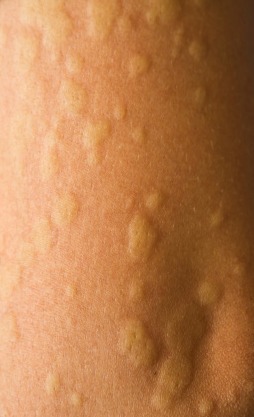Hive Causes
 The symptoms of cold urticaria include developing welts or an itchy rash after coming in from cold (especially on exposed skin), swelling of the throat or lips after eating or drinking something frozen, and/or developing an itchy rash or feeling faint after being in cold water.
The symptoms of cold urticaria include developing welts or an itchy rash after coming in from cold (especially on exposed skin), swelling of the throat or lips after eating or drinking something frozen, and/or developing an itchy rash or feeling faint after being in cold water.
People with this medical issue develop hives, or welts on their skin (that usually itch) when exposed to the cold. Reger Vein and Skin Specialists, led by Dr. Gregg Reger, provides safe, proven, and effective skin care solutions to patients in Spring, TX, The Woodlands, and surrounding locations.
What are the Other Causes of Hives?
An individual may not get hives each time they encounter something cold. Certain people only develop hives by swimming in cold water or when their skin is exposed to cold wind.
Yet others are particularly sensitive and can develop hives when they enter an air-conditioned building or stand near a freezer in a grocery store.
A majority of people who develop hives from the cold are otherwise healthy. People who develop hives from the cold do not have to necessarily live with the flare-ups. Taking certain precautions may help a person avoid hives. Medicine may be required, as well.
Prior to taking any drugs, it is vital to determine whether a person has cold urticaria.
Cold Urticaria Diagnosis
For people who think they may have cold urticaria, it might be helpful to see a qualified dermatologist. Dermatologists usually diagnose this condition and care for patients who get hives.
The dermatologist will ask the patient about the symptoms they experience when exposed to cold to understand whether they get hives from cold temperatures. The patient should inform their dermatologist if they develop any of these signs and symptoms when exposed to cold:
- Welts, at times itchy
- Swelling and redness on skin exposed to the cold
- Burning sensation
- Lightheadedness or fainting
- Swollen lips or inflammation in the throat
Correlating with this, the dermatologist may also test the skin to understand how it responds to cold. Some individuals are given the ice cube challenge test where the dermatologist places a plastic bag containing an ice cube on the bare skin, typically the forearm.
Most individuals with cold urticaria develop a welt on their skin after the bag is removed and their skin warms up. It is possible to have cold urticaria even if the patient does not develop a welt from the ice cube challenge test. Therefore, the dermatologist will ask the patient questions and assess their skin.
Treatment Options
Avoiding the reasons for the development of their hives is enough for many people to live comfortably.
In case a person has ever had a serious reaction from the cold, such as inflammation in their throat or passing out, the dermatologist will recommend that they always carry an epinephrine pen. In the event of a serious reaction, injecting themselves with an epinephrine pen could save the patient’s life.
Antihistamine medications help many people with cold urticaria as it can prevent the development of hives as well as symptoms such as itchiness. The dermatologist may prescribe a stronger drug, such as omalizumab if antihistamines are ineffective in preventing hives.
Dr. Gregg Reger provides innovative medical spa procedures and advanced skin care treatments to patients in Spring, TX, The Woodlands, and nearby areas.
For More Information contact Reger Vein and Skin Specialists in The Woodlands, TX
For more information on procedures and treatments offered by Board Certified Phlebologist Dr. Gregg Reger at Reger Vein and Skin Specialists please call 832-585-0090 or click here to contact our team. Helping patients in Houston, The Woodlands, Springs, Katy and other surrounding areas of Texas.

